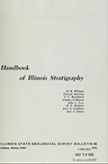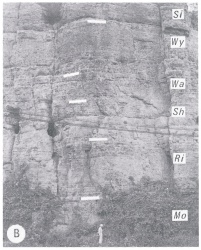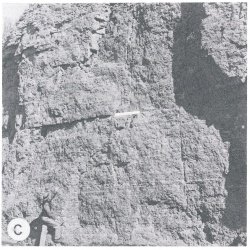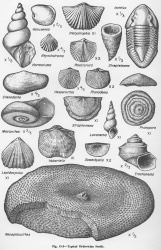Historical:Dunleith Formation
Lithostratigraphy: Ottawa Limestone Megagroup >>Galena Group >>Kimmswick Subgroup >>Dunleith Formation
Chronostratigraphy: Paleozoic Erathem >>Ordovician System >>Champlainian Series >>Trentonian Stage
Allostratigraphy: Tippecanoe Sequence
Authors
H. B. Willman and T. C. Buschbach
Name Origin
The Dunleith Formation is named for Dunleith Township, Jo Daviess County.
Type Section
The type section of the Dunleith Formation is an exposure in the Mississippi River bluffs on the north side of East Dubuque (SE 19, 29N-2W), where the formation is 132 feet thick, including the unexposed lower 20 feet (fig. O-2B). The type section for the lowest strata (the St. James and Buckhorn Members) is at Buena Vista, Stephenson County.
Other Names
The Dunleith Formation is called the "Drab" in the lead-zinc district.
Correlation
The Dunleith Formation is equivalent to the upper part of the Decorah Shale and the lower part of the Prosser Limestone in the Mississippi Valley north of Illinois, to the Jessamine, Benson, and Brannon Members of the Lexington Limestone in Kentucky, to the upper part of the Hermitage and most of the Bigby-Cannon Formations in Tennessee, and to the Kirkfield Formation, the Sherman Fall Formation, and the Rust Member of the Coburg Formation in New York.
Extent and Thickness
The Dunleith Formation is exposed (fig. O-2C) in most of the area described in the discussion of the Galena Group. It is commonly 120-125 feet thick in the northern outcrop area and is 135 feet thick near New London, Missouri, where it is overlain by the Wise Lake Formation. South of New London, where the Wise Lake and upper Dunleith beds are missing, the formation is only about 100 feet thick.
Stratigraphic Position
The Dunleith Formation (Templeton and Willman, 1963, p. 114) overlies the Guttenberg Formation and underlies the Wise Lake Formation in the Galena Group.
Description
At East Dubuque the lower 27 feet of the Dunleith Formation is dolomite-mottled lithographic limestone and the upper 85 feet is dolomite. South and east of there, the limestone is progressively replaced by dolomite from the top down, and at Galena and farther east the formation is all dolomite, except for local areas such as north of Morris, Grundy County, in which it is dolomite-mottled limestone. In northwestern Illinois the Dunleith consists of alternating pure and argillaceous units. The pure units are medium to thick bedded and vuggy and the argillaceous units thin to medium bedded and dense. Chert nodules are common, particularly in the argillaceous units. The formation is subdivided into 10 conformable members, most of them consisting of a pure unit overlain by a thinner argillaceous unit. The Buckhorn (at the base) is overlain by the St. James, Beecher, Eagle Point, Fairplay, Mortimer, Rivoli, Sherwood, Wall, and Wyota Members. In Illinois the upper six members are recognized only in the northern dolomite and limestone facies. The argillaceous content decreases eastward and southward, and the member differentiation is less useful in the central northern outcrop area, although most of the members can be identified by such minor characteristics as abundance and types of chert, persistent thin bentonite beds, corrosion zones, fucoidal zones, and common fossils. In subsurface in northeastern Illinois the formation is even purer, contains little or no chert, and its members have not been differentiated (Buschbach, 1964). The southern limestone facies occurs throughout central and southern Illinois but is exposed only at Lowell, La Salle County, at Valmeyer, Monroe County, and near West Point Landing, Calhoun County. The lower four members are recognizable in the outcrops but rarely in subsurface. The overlying part of the Dunleith is divided into only two members, a lower massive calcarenite (Moredock Member) and an upper cherty, thin- to medium-bedded, calcarenitic limestone (New London Member).
Fossils
The Dunleith is sparsely fossiliferous in the dolomite facies, although Paucicrura [Dalmanella], Prasopora, and Receptaculites (fig. O-5) characterize certain zones. Bryozoans and crinoidal debris are particularly abundant in the southern limestone facies.
References
BUSCHBACH, T. C., 1964, Cambrian and Ordovician strata of northeastern Illinois: Illinois State Geological Survey Report of Investigations 218, 90 p.
TEMPLETON, J. S., and H. B. WILLMAN, 1963, Champlainian Series (Middle Ordovician) in Illinois: Illinois State Geological Survey Bulletin 89, 260 p.
ISGS Codes
| Stratigraphic Code | Geo Unit Designation |
|---|---|



